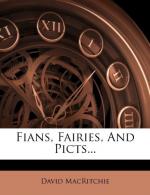Before parting altogether from the Yesso dwarfs, notice may be taken of a folk-tale containing an incident which obviously derives its existence from them, or from a branch of their race. In Mr. Andrew Lang’s “Green Fairy Book” there is introduced a certain Chinese “Story of Hok Lee and the Dwarfs.” It appears to be also current in Japan, to judge from a reviewer’s remark, that “the clever artist who has illustrated the book must have known the Japanese story, for he gets some of his ideas from the Japanese picture-maker.” In the story of Hok Lee the dwarfs are represented as living in subterranean dwellings, and in the picture they are portrayed as half-naked, with (for the most part) shaggy beards and eyebrows, and bald heads. It is wonderfully near the truth. The baldness is one of the most striking characteristics of those actual dwarfs, and is caused by a certain skin-disease, induced by their dirty habits, from which a great number of them suffer, or did suffer. The shaggy beards and eyebrows are equally characteristic of the race; and their custom of occupying half-underground dwellings has given them the name by which they are remembered in Japan at the present day. The exact scene of the story is a matter of minor importance. Those people appear to have been known to the Chinese for at least twelve centuries, and to the Japanese for a much longer period. Thus, it was quite unnecessary for any novelist in China or Japan to invent such people, since they already existed. As for the details of that particular story, or of any other of the kind, it is not to be supposed that a belief in its historical basis necessarily implies an acceptance of every statement contained in it. On this principle, one would be bound to accept the truth of every “snake-story,” for the simple reason that one believed in the existence of snakes. Still, it is possible, and perhaps not improbable, that tales which preserve the memory of those people, may also be fairly accurate in many of the statements made regarding them. The reason, however, of introducing this particular story is to show that the Chinese or Japanese romancer did not require to create a race of bald-headed, shaggy, half-wild dwarfs, seeing that that had already been done for him by the Creator.
Those to whom this question is a new one will now see what is the point of view of the realist or euhemerist with regard to such traditions. He sees here and there in the past, through much intervening mist, something that looks like a real object, and he tries to define its outlines. He has no intention of denying, as some have vainly imagined, that there is an intervening mist. Nor, it seems necessary to explain, does he assume that wherever there is a mist there must be some tangible object behind it. For example, he does not believe that Boreas, or Zephyrus, or Jack Frost were ever anything but personifications of certain natural forces.




